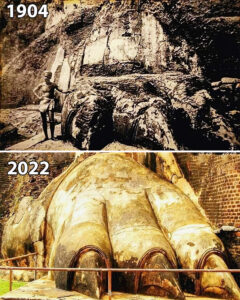Introduction to Sigiriya
Sigiriya, often called the “Eighth Wonder of the World,” is a striking ancient fortress in the heart of Sri Lanka. Rising nearly 200 meters (660 feet) above the surrounding jungle, this rock fortress has fascinated historians, archaeologists, and travelers for centuries. At its entrance stands the famous Lion’s Paw—a testament to the grandeur of the site and its historical significance. Declared a UNESCO World Heritage Site, Sigiriya combines rich cultural heritage, advanced ancient engineering, and stunning artistry.
A Brief History of Sigiriya
The Reign of King Kashyapa
Sigiriya’s origins trace back to the 5th century when it was chosen by King Kashyapa (477–495 CE) as the site for his new capital. Known for its strategic location and natural defenses, the rock was transformed from a massive stone monolith into a fortress-palace. To create this impressive stronghold, the king’s architects incorporated water gardens, defensive structures, and elaborate staircases, all of which led to the magnificent palace at the summit.
The Lion’s Paw Staircase
The iconic Lion’s Paw marks the remnants of a massive stone lion sculpture that once formed the entrance to the palace. Originally, visitors would pass through the lion’s open mouth, climb the stairs under its watchful eyes, and ascend to the royal palace above. Today, all that remains of this once-grand structure are the lion’s paws, yet they continue to evoke the power and mystique of ancient Sigiriya.

Restoration and Preservation Efforts
Early Restoration Efforts
Sigiriya began to capture global attention in the early 20th century, sparking preservation efforts in 1904 led by British and Sri Lankan archaeologists. These pioneers faced challenges in restoring the site, but their work ensured that Sigiriya’s heritage would be preserved for generations. Restoration and conservation projects have continued to evolve, preserving the Lion’s Paw, frescoes, and surrounding gardens from damage over time.
Modern Preservation from 1904 to 2022
From 1904 to 2022, the preservation of Sigiriya has seen major developments. Conservation teams have worked to stabilize the rock and restore its structural integrity, allowing visitors to explore this historical site safely. Techniques include using environmentally friendly chemicals, meticulous cleaning, and employing high-tech monitoring systems to prevent erosion.
Cultural and Architectural Significance
Intricate Frescoes
Sigiriya is home to an array of vibrant frescoes depicting heavenly maidens, believed to represent either celestial beings or important figures of the time. The frescoes showcase artistic skill and attention to detail, with vivid colors that have remarkably survived centuries. This unique artwork reflects the cultural sophistication of the ancient Sri Lankan civilization.
Advanced Engineering and Water Management
Sigiriya is not just a marvel for its artistic achievements; it also displays advanced engineering. The site features an intricate hydraulic system, complete with ponds, fountains, and underground water conduits. This system functioned to provide a consistent water supply to the gardens and pools, even during dry seasons, and it is still partially functional today.
Significance of the Lion’s Paw in Sri Lankan History
The Lion’s Paw is more than a mere architectural element; it represents the enduring power of Sigiriya as a symbol of Sri Lankan pride and resilience. It has witnessed centuries of political, cultural, and religious transformations, each adding to its historical richness. The lion, a symbol of strength and royalty in ancient Sri Lankan culture, continues to embody national identity, symbolizing the strength of the Sri Lankan people.
Visiting Sigiriya Today
For visitors to Sri Lanka, Sigiriya offers a unique journey into the past. Travelers can explore the Lion’s Paw and climb to the top, where panoramic views of the surrounding jungle reveal the full scope of this incredible structure. The trek is both physically challenging and spiritually rewarding, offering insight into an era marked by monumental ambition, artistic brilliance, and enduring heritage.
Conclusion: The Legacy of Sigiriya
Sigiriya’s Lion’s Paw, its frescoes, and the palace ruins represent an irreplaceable part of human history. As one of the best-preserved examples of ancient urban planning, the site offers valuable insights into engineering, art, and governance from over 1,500 years ago. Today, the site serves as a reminder of human ingenuity and the timeless nature of Sri Lanka’s heritage.
